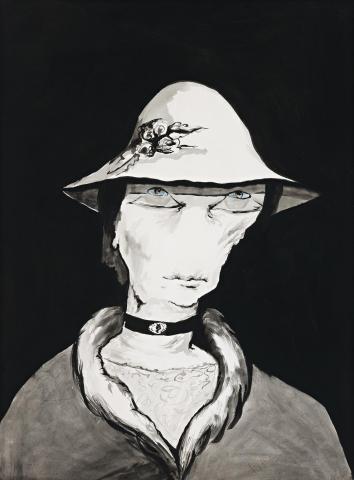OLD WOMAN, 1955
JOY HESTER
brush and ink, and blue crayon on paper
74.0 x 54.5 cm
signed and dated lower right: Joy Hester ‘55
Tolarno Galleries, Melbourne (label attached verso)
Private collection, Melbourne
Possibly Mirka Café, Melbourne, July 1955
Probably Joy Hester, Tolarno Galleries, Melbourne, 6 – 25 October 1976
Leave No Space for Yearning: The Art of Joy Hester, Heide Museum of Modern Art, Melbourne, 25 August – 11 November 2001
Gellatly, K., Leave No Space for Yearning: The Art of Joy Hester, exhibition catalogue, Heide Museum of Modern Art, Melbourne, 2001, p. 51
Head of a Woman with Hat, 1955, brush and ink, and blue crayon, 75.4 × 50.4 cm, in the collection of the National Gallery of Victoria, Melbourne, illus. in Burke, J., Joy Hester, National Gallery of Victoria, Melbourne, 1981, pp. 44 – 45
Alongside Sidney Nolan and Albert Tucker, Joy Hester was a central figure among the group of artists who gathered around John and Sunday Reed at Heide. The Reeds were enlightened patrons of contemporary art, providing financial, moral and emotional support to these young artists in whom they identified great promise, and their home in the rural outer-Melbourne suburb of Heidelberg became a hub for many of the most avant-garde artists, writers and thinkers of the day, ‘a vibrant intellectual environment and … haven of shared ideas … a source of fresh produce in wartime, and an invaluable collection of books and journals’.1 Following their first meeting at the Herald exhibition of French and British Art in 1939, Hester and Sunday Reed established a lifelong friendship which was as complex as it was steadfast, including an intimate romantic liaison and the Reeds’ adoption of Hester’s son Sweeney in 1949.2
Hester painted predominantly on paper, using brush and ink, watercolour and gouache, and had a facility with these media that allowed her to work in a manner that appeared both spontaneous and intuitive. As Barrett Reid recalled, ‘Joy drew the way other people speak; it was as natural and as simple as that … I can see her now, in this room (the library at Heide) … in front of her would be a whole pile of paper which she’d be drawing on and taking part in the conversation laughing, interrupting, listening intently to what everyone was saying and drawing at the same time’.3
Following the tumultuous events of the late 1940s – including the end of her marriage to Albert Tucker, Sweeney’s adoption and Hester’s diagnosis with Hodgkin’s disease – the early 1950s represented a period of relative contentment. By 1955 she was living in rural Avonsleigh with the poet/painter, Gray Smith, and their two young children and despite a constant lack of money, it was a happy and artistically productive time. Charles and Barbara Blackman lived nearby, co-conspirators in variously successful money-making ventures, as well as creative compatriots. Led in part by Hester’s example, Charles Blackman worked exclusively on paper while at Avonsleigh and in turn, he encouraged Hester to use process black, a dense black ink used by commercial printers, to make her work ‘sterner’. 4
Old Woman, 1955 is part of an informal group of works Hester made during these years that depict the down-to-earth, country people she encountered at Avonsleigh and Upwey, where the family moved later that year. Hester’s maturity and growing confidence as an artist is reflected in these drawings including Woman, 1955 (TarraWarra Museum of Art, Victoria) and Man in cork hat, 1957 (National Gallery of Victoria, Melbourne), which are more ambitious in their level of detail and finish, as well as larger in scale than much earlier work. The subject and composition of the present drawing is closely related to (Untitled)(Head of a woman with hat), 1955 (National Gallery of Victoria), although it clearly depicts an older woman. Wearing a fur-collared coat, cameo choker and a hat decorated with flowers, the figure is dressed in her Sunday best, but as is so often the case in Hester’s art, it is the face and knowing eyes – the only place where colour is used – that draw us in and speak to the humanity of the subject and in this case, the wisdom and experience of a life long-lived.
1. Gellatly, K., Leave no space for yearning: The Art of Joy Hester, exhibition catalogue, Heide Museum of Modern Art, Bulleen, 2001, p. 12
2. See Harding, L. & Morgan, K., Modern Love: The Lives of John & Sunday Reed, The Miegunyah Press, Victoria, 2015
3. Reid, B. quoted in Gellatly, K., op. cit., p. 14
4. Gellatly, K., op. cit., p. 37
KIRSTY GRANT
